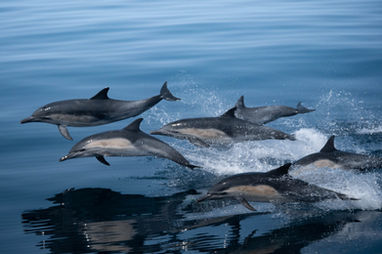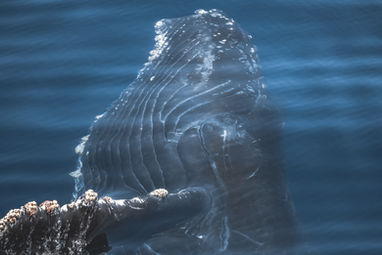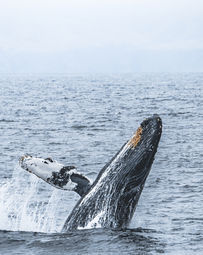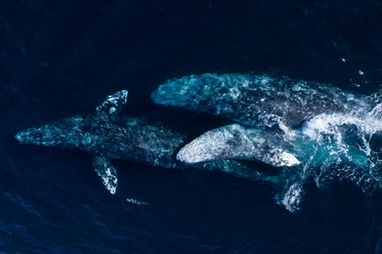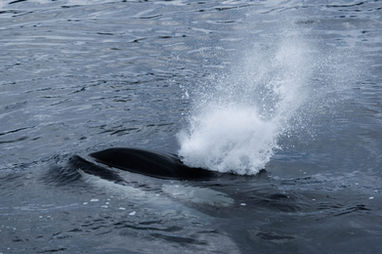Located in Santa Barbara, the Condor Express has offered the best whale watching excursions in Southern California for over 30 years. We take immense pride in our astounding sightings history and success over the years. Whale migrations vary slightly from year to year, but our experienced crew has decades of experience out on the water, giving you the best chances to see these wild animals!
Our typical calendar year is split up into TWO SEASONS.
From the second week of February to the second week of May, we run 2.5 hour "coastal" trips in search of gray whales. Gray whales MIGRATE THROUGH our channel as they embark on the longest mammalian migration on the planet. They swim 10,000+ miles from their feeding grounds in the Alaskan seas, to their breeding grounds in the lagoons of Baja California. During these 2.5 hour trips we also see common dolphins and California sea lions on NEARLY EVERY TRIP.
(In recent years humpback whales have also made an early return to the channel and are often seen on these 2.5 hour trips).
From the second week of May to the second week of February, we run 4.5 hour "open channel" trips in search of humpback, blue, and fin whales. These whales MIGRATE TO this channel to feed! Humpbacks will begin to show up in early spring and stay with us in the channel until late fall/ early winter, where they too go down to Mexico for their breeding season. Blue and fin whales typically show up later in the summer in late July, August, and September. They are krill specialists, so wherever the large krill swarms show up, these giants won't be far behind! These longer trips also allow us to explore the 4 northern Channel Islands, if weather and whale sightings permit.

Beautifully white tail fluke from a humpback whale

The Condor Express shadowed by the beautiful Santa Ynez mountain range.

2 adult gray whales traveling past Santa Barbara. One raises its mighty tail flukes as another shoots a "rainblow" into the sky!

A stampede of common dolphins! This group consisted of 2,000 individuals and sustained speeds of 17 knots for 20 minutes straight.
SANTA BARBARA WHALE WATCHING
Experience one of the most diverse marine hotspots the West Coast of the U.S. has to offer!
We patrol a relatively shallow channel encompassed by the Channel Islands National Park. This creates a very unique marine topographic region along coastal California. Pair this with nutrient-rich upwelling, and it creates the perfect recipe for a bloom of life. From Winter-Spring, enjoy Pacific gray whales as they journey from their feeding grounds in the Alaskan seas to their breeding grounds in small lagoons off of Baja California. December and January offer the best looks at these barnacled bottom feeders as they stroll south past the Channel Islands, while February-April offer the best looks right off the California Coast! From spring to fall, whales and dolphins feed in the Santa Barbara Channel. Large aggregations of humpback whales and their sidekick companions, the common dolphin, forage for anchovies in the channel. Blue whales feed along island drop-offs on the abundance of krill that the channel has to offer. Killer whales creep into the channel a couple of times a year to snatch an afternoon snack. They're rare but so worth the effort put into finding them!
We are typically the only ones patrolling the channel looking for whales; we usually have them all to ourselves! We offer a unique whale watching experience in Southern California's most diverse marine feeding ground. Come join us!


2 California sea lions that regularly feed with the whales

A common dolphin rockets out of the water, while eyeing our photographer.

A mighty blue whale coming to the surface after a deep dive on krill.
THE WILDLIFE
COMMON DOLPHINS
DELPHINUS DELPHIS
Common dolphins are incredible beings! Their name doesn't do their beauty, intelligence, or acrobatics justice. Commons are seen on almost every trip while out exploring the channel; Southern California is the best place to see common dolphins in the world! We see two different types of common dolphins in the channel, long beaked common dolphins and short beaked common dolphins. Scientists have long debated if there's enough difference between the two to separate them into distinct subspecies or not. As of now they're considered the same species.
HUMPBACK WHALES
MEGAPTERA NOVAEANGLIAE
Humpback whales are our most frequently seen whales from March-November. An estimated population of about 5,000 of these gentle giants call the California coast home for the feeding season. They're by far the most curious whale we see and often come over to investigate our vessel! Like all baleen whales, humpbacks don't form familial pods like our toothed whales do. However, when feeding conditions are just right, we see large aggregations of humpbacks feeding together in the channel. The Santa Barabara channel is undoubtedly the best place to see these magnificent whales in Southern California waters.
BLUE WHALES
BALAENOPTERA MUSCULUS
Blue whales are the largest animal to ever call our planet home! Their shear size and beauty is always welcomed in our channel. Our population of about 2,000 animals is considered one of the largest populations of blue whales in the world, yet they're still considered endangered. Where humpbacks, minke, and fin whales will gorge themselves on small fish like anchovies, blue whales are krill specialists. Their abundance and location along the west coast is dependent upon where the krill is. Sightings vary from year to year, but when there's high densities of krill in the channel, the blue whales will be here to take advantage!
GRAY WHALES
ESCHRICHTIUS ROBUSTUS
Gray whales are deeply rooted in Californian and American history. The whale seen the most from California's shoreline, gray whales are long distance travelers. They travel past our coast as they migrate from their feeding grounds in the Alaskan seas, to their breeding grounds in lagoons off the coast of Baja California. They travel in large groups sometimes consisting of a dozen whales! While these whales don't typically feed of our coast, we do sometimes find them feeding down in the mud. They are part of the baleen whale family, but feed down in the mud on small crab like creatures called amphipods. Totally different than blue of humpback whales! We typically watch them on their southbound migration along the islands during December and January, then again on their northbound migration from February to May. Mothers and calves are the last to leave the lagoons, typically during April and May.
KILLER WHALES
ORCINUS ORCA
The animal we get asked about the most, killer whales! (Orca). While we've had the best success rate at finding these elusive predators in Southern California waters they're still extremely rare. We typically only get a handful of sightings a year! They're without a doubt the oceans top predator, but can often times be innately curious of us and our passengers. We see them spy hopping (taking a look above the water), and sometimes seem to bring over their mid day lunch for us to investigate. While we can see them any month of the year, we typically get our most sightings in April/ May, and September-December.


